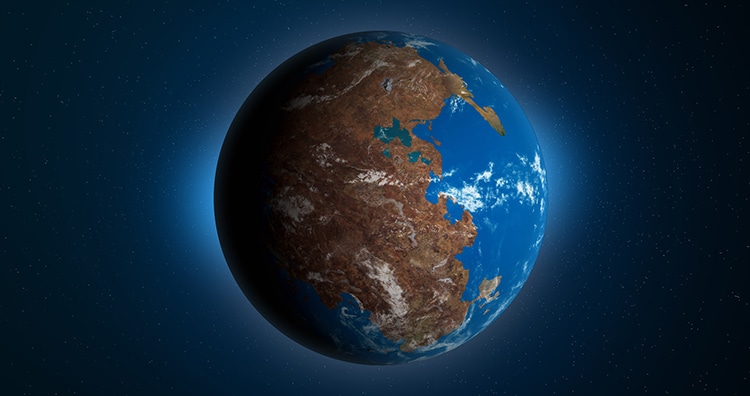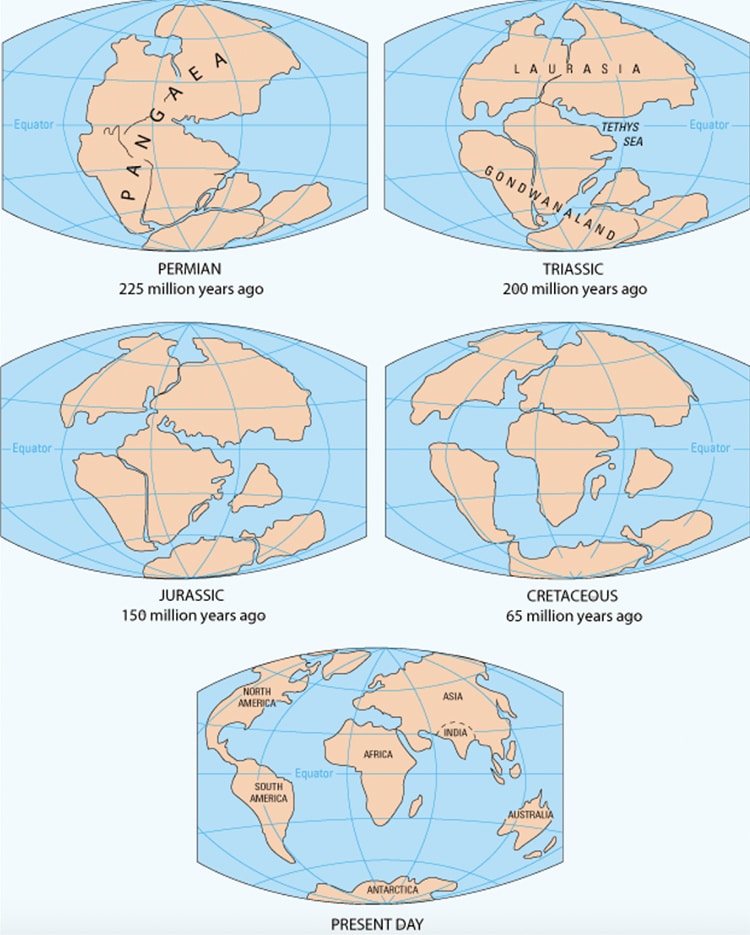
An artistic rendering of what Pangea Proxima might look like. (Photo: IANM36/Depositphotos)
You probably learned about Pangea, also spelled Pangaea, the prehistoric supercontinent that once hosted the earliest dinosaurs. Around 200 million years ago, the process known as continental drift began to shift portions of land apart. Riding the tectonic plates, the continents separated and migrated to their current locations. Yet Earth’s surface is not static. Continents continue to shift, causing the Himalayas to rise slightly each year and the continents to continually, slowly move. In fact, recent scientific estimates suggest that in about 250 million years, the continents will merge back together into a supercontinent.
This supercontinent may take several different forms. Under a scenario known as Aurica, an equatorial continent forms. To form Amasia, the continents would converge on the North Pole, with Antarctica remaining at the South Pole. Novopangea sees the Pacific Ocean closing. For Pangea Ultima, or Proxima, the continents converge around a small ocean or sea. Pangea Proxima means “the next pangea,” harkening back to the prehistoric state of affairs. According to a recent paper published in Nature Geoscience, Pangea Ultima will, “due to changes in volcanic rifting and outgassing . . . [and] solar energy . . . and continentality (larger range in temperatures away from the ocean) lead to increasing warming hostile to mammalian life.” The authors conclude it “will probably lead to a climate tipping point and their mass extinction.”
If this mass extinction is terrifying, it is ultimately the natural course when viewing history through the millions of years. The Sun will only get hotter as the star ages, so the Earth will eventually face more radiation. The dinosaurs went extinct in a similar event, although their crisis was partly caused by an asteroid impact and volcanoes.
“It might end up looking a lot like Pangea did when the dinosaurs were roaming around,” Hannah Davies, a geologist who studies supercontinents, told Mashable. “We could end up with six or seven supercontinent cycles throughout Earth’s history.”
Millions of years ago, our seven continents were mashed together into one supercontinent, and current science suggests that they will eventually return to this formation.

The break up of the original Pangea into our present day map. (Photo: Wikimedia Commons, Public Domain)
In one proposed formation called Pangea Ultima, all of the continents will converge around a small ocean.

What Pangea Proxima or Ultima may look like, as postulated by Paleomap Project. (Photo: Cgboeree via Wikimedia Commons, CC BY-SA 4.0 DEED)
Scientists suggest that this will likely occur about 250 million years from now.
When it happens, it will create a climate tipping point that will drive a mass extinction, similar to what happened to the dinosaurs.
New paper alert “Climate extremes likely to drive land mammal extinction during next supercontinent assembly” in @NatureGeosci . w/ @EuniceLoClimate , Paul Valdes, @JonathanRBuzan , @bjwmills , Andrew Meredith, @chris_scotese , @StellarPlanet 1/nhttps://t.co/aKsWJxbrln
— Alex Farnsworth (@Climate_AlexF) September 25, 2023
h/t: [Mashable]
Related Articles:
World’s Oldest Piece of Fossilized Skin Is Discovered in Oklahoma Cave
Man Walking His Dog Finds 70-Million-Year-Old Dinosaur Skeleton in the Woods
16-Million-Year-Old Skull of Extinct Species of Giant Dolphin Discovered in Peru
Amateur Paleontologist Discovers 70-Million-Year-Old Fossil While Walking His Dog
